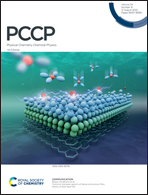DFT–ReaxFF hybrid molecular dynamics investigation of the decomposition effects of localized high-concentration electrolyte in lithium metal batteries: LiFSI/DME/TFEO†
Abstract
Due to its low electrochemical potential and high theoretical specific energy, lithium-metal batteries (LMBs) have been considered as a promising advanced energy storage system for portable applications such as electric vehicles (EVs). However, the uncontrolled growth of lithium dendrites during cycling has remained a challenge. By utilizing an inert solvent to “dilute” the high concentration electrolytes, the concept of localized high-concentration electrolytes (LHCEs) has recently been demostrated as an effective solution to enable the dendrite-free cycling of LMBs. In this work, we investigated the reactions of 2 M lithium bis(fluorosulfonyl)imide (LiFSI) in a mixture of dimethoxyethane (DME)/tris(2,2,2-trifluoroethyl) orthoformate (TFEO) electrolyte at a Li metal anode. The SEI formation mechanism is investigated using a hybrid ab initio and reactive force field (HAIR) method. The 1n reactive HAIR trajectory reveals the important initial reduction reactions of LiFSI, TFEO, and DME. Particularly, both FSI anions and TFEO decompose quickly to release a considerable amount of F-, which leads to a LiF-rich SEI inorganic inner layer (IIL). Furthermore, TFEO produces a significant amount of unsaturated carbon products, such as thiophene, which can potentially increase the conductivity of SEI to increase the battery performance. Meanwhile, XPS analysis is utilized to further investigate the evolution of the atomic environment in SEI. Future designs of better electrolytes can be greatly aided by these results.



 Please wait while we load your content...
Please wait while we load your content...